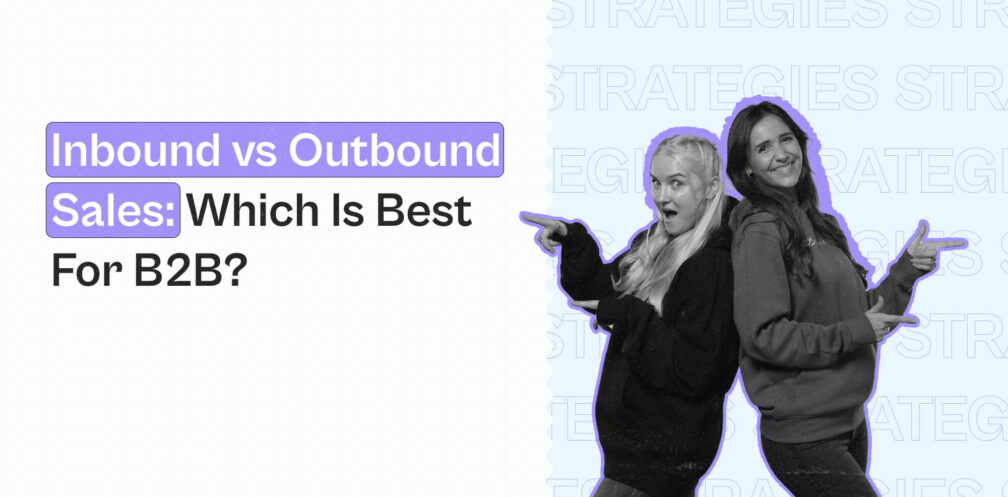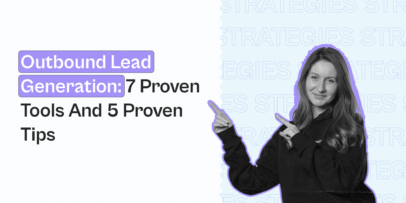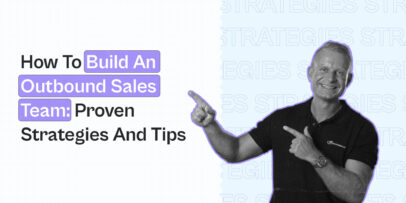Inbound vs Outbound Sales: Which is Best for B2B?

Every sales team faces the constant dilemma between inbound and outbound sales.
While inbound sales are cost-effective but time-consuming to see actual results, outbound sales have a more personalized touch with some upfront costs.
So we get it if you’re constantly battling between inbound vs outbound sales or looking for a hybrid approach with the best of both worlds.
This guide unpacks everything about outbound vs inbound sales and offers practical ways to leverage these strategies.
Inbound vs Outbound sales – what’s the difference?
Before we dig into the specifics, here’s a quick overview of the two powerful sales strategies:
| Inbound sales | Outbound sales |
| Prospects are aware of your brand or solutions | Prospects may or may not be aware |
| Prospects make the first move | You reach out to prospects via cold outreach methods |
| Scalable and cost-effective | Scalable and budget-friendly for high-cost products |
| Basic targeting | Precise targeting |
| Time-consuming to see real results | Results can be quick if the outreach is on point |
| Longer sales cycles as prospects may take time researching and engaging with your brand | Shorter sales cycles as reps try to nurture leads and close deals quickly |
| Examples include blog posts, case studies, testimonials, webinars, and eBooks | Examples include cold calling, cold emailing, social selling, and in-person events |
Now, let’s examine these factors to find which strategy suits your business.
What are inbound sales?
Inbound sales are customer-centric approaches that try to draw potential customers organically to your brand via tailored content. Most targeted prospects may already be familiar with your brand or products.
Inbound sales mainly focus on:
- Engaging with potential customers to understand their needs and expectations
- Attracting them with content engagement tactics, such as advertising, content marketing, or word-of-mouth
- Personalizing their experience interacting with your brand and guiding them through their buying journey
Inbound sales strategy – examples of inbound sales and the role of content
Inbound sales strives to create high-quality, personalized content that resonates with prospects’ challenges and interests. This way, you showcase your brand as the go-to trusted source right from the first customer touchpoint.
Such content can take the shape of:
- Website blog posts
- Newsletters
- Whitepapers
- Case studies
- Infographics
- Social media posts
- Webinars
- And other content that drives brand value and awareness
3 examples of inbound sales for B2B
Some of the most common yet effective ways prospects can find you are through:
1. Content marketing
Your prospect browses for content online by typing in keywords and clicking content, such as blog articles they find most relevant. That’s what content marketing is about.
For example, a prospect searches for “the best video marketing software,” and a blog post on the best video marketing software for 2024 pops up. They click on the piece of content that explains the pros and cons of the best software in the market and eventually, are persuaded to sign up for the product demo.
2. Word-of-mouth or referrals
Word-of-mouth marketing or referrals are gained when your existing satisfied customers recommend you to people in their circles.
For example, you could offer a referral discount to your current customers. They could share this code with someone who signs up for your service, gaining a new customer while your old customers enjoy a discount.
3. Search engine advertising
This is similar to the content marketing process, but it’s paid content. Ads are displayed when potential customers search for a specific keyword or phrase. They can click on the ad, which takes them to a landing page.
For example, a potential customer runs a Google search for “B2B marketing agencies near me.” An ad for a nearby agency might pop up. The customer might click on the ad and be taken to the agency’s website to submit an inquiry form.
Lead generation benefits of inbound sales
Here are some primary benefits of running inbound sales strategies in generating high-quality leads:
- Valuable content, which is at the core of inbound sales, can engage prospects, get them interested in your offering, and triple the chances of conversion.
- Inbound equals customer-centric sales. When brand messaging becomes personal, it often leads to increased customer satisfaction and loyalty and, as a result, more referrals.
- The best part of generating content for inbound sales is that it’s absolutely free (unless you take the paid ads route, of course!) So, read – higher ROI.
- Scalable lead generation, meaning content can be re-used and refreshed to continue attracting and converting hot leads.
What are outbound sales?
Outbound sales are when a salesperson reaches out to prospects directly. These prospects may or may not be aware of your brand and solutions. So, this requires the salesperson to perform adequate research and personalize their outreach efforts from the first contact.
Outbound sales mainly focus on:
- Hyper-targeting outreach by identifying prospect profiles that fit your ideal customer profile (ICP)
- Using cold outreach methods to generate high-quality leads
- Crafting personalized connection messages and follow-ups to form a genuine connection with the prospects and move them further down the sales funnel
- Handling potential objections the prospects may have
Outbound sales strategy – examples of outbound sales and the role of cold and warm outreach
Generic outreach is a big no-no in outbound sales. Personalization and proactive outreach are the core of this strategy. However, the first step to acing this strategy involves building solid brand awareness by sharing valuable content that displays your industry expertise.
How’s outbound different from inbound?
A proactive lead generation strategy in outbound sales can involve cold calling, cold emailing, and cold/warm messaging.
Yes, outreach can be cold or warm. While cold outreach in outbound sales involves reaching out to leads with all types of awareness levels, warm outreach involves reaching out to leads with basic to advanced awareness about your brand.
These outreach approaches can involve:
- Networking with prospects on B2B social media platforms like LinkedIn
- Sending personalized LinkedIn connection requests and cold emails
- Inviting cold leads to company events
- Cold calling
3 examples of outbound sales for B2B
Let’s take a deeper look at some examples of B2B outbound sales in action:
1. Cold LinkedIn outreach
Most sales reps tap into LinkedIn due to its outstanding B2B presence. They start filtering out ICP profiles to send them a hyper-personalized connection request.
Remember, cold LinkedIn outreach cannot be done overnight for optimum success. You must first optimize your LinkedIn profile to match your targeted ICP.
For instance, adding a LinkedIn profile headline that addresses how you fix the target audience’s pain point, like so:
👉 Check out this free eBook on optimizing your LinkedIn profile for lead generation.
2. Cold emailing
Cold emails involve sending customized emails to your targeted ICPs who have not interacted with your brand before. Proper personalization encourages response.
For example, if you’re reaching out to B2B prospects who may need a marketing automation solution, your subject line and email body must be as personalized as possible.
Sample subject line: “[Prospect_name], quick question on [their company]”
3. Events or trade shows
With everything going digital, we often forget that sales and marketing can still happen in person. That’s why B2B events and trade shows are important.
For example, sales reps or account executives can pre-identify attendees who fit their ICP and contact them directly to have face-to-face conversations to gauge their interest in your solutions.
Lead generation benefits of outbound sales
Here’s why outbound sales and effective lead generation go hand in hand:
- The biggest advantage of outbound sales is the ability to generate leads quickly compared to inbound. Instead of waiting around for results, sales reps take matters into their own hands by reaching prospects proactively and entering niche markets in less time.
- Inbound sales make it difficult to reach key decision-makers at your targeted companies. However, outbound sales allow direct access to them, thus shortening the sales cycle.
- More room for personalization since you’re targeting individuals rather than a wide range of people.
How to implement inbound sales strategies
Built trust through content creation
As we previously discussed, content creation for inbound sales can involve blog posts, social media posts, webinars, eBooks, and more.
For example, Expandi’s inbound strategy includes free eBooks on targeted topics that the end users would find helpful:
Such thought-provoking content builds trust in your brand and lets prospects view you as the go-to industry expert in your specific niche. This trust eventually leads to interest in your products or services.
Use social proof like customer testimonials to create brand awareness
People listen to people. And there are no better brand advocates than your satisfied customers. So, collect genuine customer testimonials from them to foster brand awareness.
The best part of testimonials is their reusability. You can upload them to your website or key landing pages as widgets, convert them into social media posts, or add them to your emails.
Here’s an example of how we at Expandi display customer testimonials on our homepage to attract website visitors with the right dose of credibility:
How to implement outbound sales strategies
Always personalize your cold outreach
Personalized cold outreach involves tailoring every message you send to prospects across touchpoints. You can address their needs, challenges, or interests to strike an instant connection.
This form of outreach can occur through various mediums, such as emails, phone calls, direct mail, or social media messaging.
The ultimate goal with this form of personalization is to let prospects know that your product or service solves their problem.
Let’s take an example of a LinkedIn cold outreach strategy.
You sell a digital team management assistant. You want to reach out to B2B leads on LinkedIn, specifically, IT Directors whose teams are experiencing a communication misalignment.
Do you plan to jump on the opportunity and send them a LinkedIn connection request?
Not until you qualify for the below prerequisites:
- An optimized LinkedIn profile that aligns with the target ICP and buyer personas’ needs and pain points. For example, a headline and summary that tells how your product fixes misaligned teams
- Being regular with sharing LinkedIn content that can reach the target market and encourages them to engage with your posts
- Being active on LinkedIn groups where your target ICP is present by sharing anecdotes, market trends, and engaging on others’ posts
- Using safe LinkedIn engagement pods to give your posts an initial boost of engagement so they reach the target audience
These prerequisites to cold outbound outreach are necessary because the more engagement your posts have and the more followers you start to gain, the higher your chances of gaining potential customers’ trust to buy from you.
Going back to our example above, now that your posts are gaining some traction, you can start planning outreach by scraping accounts that have engaged with them.
Use an automated tool like Expandi to perform this task safely and swiftly.
Expandi has a “Post engagement” search option that scrapes those who have interacted with any LinkedIn post and prepares it as a downloadable CSV file ready for outreach.
Once you have your scraped list ready for outreach or nurturing, you can use a template like the one below to personalize your connection request:
“Hi [first_name], Saw you also liked a team management hack by [influencer]. I share frequent titbits on this very topic. Would love for you to check them out! Let’s connect, Stefan”
Perfect and polish your cold outreach structure
If personalization is one pole of outbound sales, clarity in communications is the other.
Clear communication is essential to concisely communicating your product’s unique value proposition. Without this, prospects would be left wondering what you sell and why you’re reaching out to them.
So always understand their perspective before framing a cold outreach messaging or emailing structure to multiply the chances of conversion.
For example, answer the “whys,” “whats,” and “whens” while reaching out or following up with prospects to sell a solution.
👉 Read this guide for help with structuring cold outreach on LinkedIn to win those high-potential B2B leads for your business.
The best of both worlds – how the combination of inbound and outbound sales can do wonders for B2B lead generation
It’s high time both these sales strategies co-existed to maximize lead generation efforts,
That’s because inbound sales are super capable of building brand trust and awareness with awesome content, while outbound sales leverage proactive outreach.
Combining the two ensures you’re building brand value and awareness and, at the same time, reaching out to those who may be unaware but ready for conversion.
So, are we pushing a hybrid approach? The answer is yes!
Wrapping up – Inbound sales vs outbound sales
The final takeaway from this article should be that both strategies are important to growing your business and generating a consistent flow of leads.
So, use both strategies to find and nurture leads effectively.
You can start your outbound sales strategy to qualify and reach out to leads with a safe LinkedIn automation tool like Expandi.
You’ve made it all the way down here, take the final step


